The Application of FT-NIR and Multivariate Analysis Methods for Characterization of an Industrial Mold Purging Process
Special Issues
Near infrared (NIR) reflection spectroscopy and multivariate analysis have been used to characterize materials relating to an injection mold barrel purging process. NIR was compared to attenuated total reflectance-mid-infrared (ATR-MIR) spectral measurements to assess whether the NIR measurement was relevant to either the surface or the bulk of the samples.
A combination of near infrared (NIR) reflection spectroscopy and multivariate analysis has been used to characterize materials relating to an injection mold barrel purging process. Reference spectra from unprocessed mold and purge materials have been compared with samples prepared after purging to estimate the content of residues in samples after a series of purging steps. Based on the results of principal component analysis and multivariate curve resolution, injection molded samples compare best with reference nylon after two purges of the barrel. Comparison of analysis of the results from the NIR and attenuated total reflectance-mid-infrared (ATR-MIR) spectral measurement was carried out to assess whether the NIR measurement was relevant to either the surface or the bulk of the hub samples.
Nylon hubs, used in the construction of neurovascular catheters, may be manufactured using injection molding. After repeated use, nylon residues build up in the barrel, and these must be removed to prevent contamination. This is accomplished by using a purging material that is fed through the injection mold barrel, removing residues as it is passed through. In doing so, the barrel becomes contaminated temporarily by the purge material, and this is removed by running several blanks of the material that is normally injection molded using the purged barrel (1).
The industrial client for whom we carried out this analysis has switched from one purging material to another. They wished to determine the point at which the hubs are clear of residues associated with the barrel and the purge material. Determination of the point at which the barrel residues and purging materials are no longer present, as contamination in the molded pieces is often estimated using visual inspection alone. However, this method has an inherent uncertainty. We present a method based on the combination of near-infrared (NIR) spectroscopy and multivariate analysis techniques that allows for the clear identification of the point at which no further purging is necessary.
NIR spectroscopy is an established technique used for analyzing polymers. Absorption of NIR light by a polymer sample may occur by interaction with vibrational overtones and sum tones of chemical functional groups such as N-H, C-H, and O-H. These functional groups are common to a range of polymers, and contribute to a given polymer's spectral fingerprint. The spectrum may be used to discriminate between materials and to measure concentrations of mixtures. Measurement of the NIR spectrum is non-destructive, and sample preparation is generally minimal or unnecessary (2). Principal component analysis (PCA) is a multivariate analysis technique that is sensitive to changes in process conditions. The scores calculated from PCA of a data set allow for visualization of the relationships between the samples in a set. Clusters, patterns, and trends are revealed, and these are interpreted based on the context of and prior knowledge relating to the sample set (3). Multivariate curve resolution (MCR) is a complementary multivariate analysis technique to PCA. It differs from PCA in that the information used in the analysis is not abstract. Loadings describing components calculated using PCA are abstract solutions, whereas those calculated using MCR or inputted into an MCR model are related to the actual physical characteristics of the sample. It is often used in the spectroscopic analysis of mixtures (4).
Materials and Methods
Nylon pellets, polystyrene pellets, and sample hubs were supplied by Stryker Neurovascular. Sample hubs or "blanks" were molded and collected after purging of the mold barrel. Blanks were collected from each of the five moldings after the first purge. Blanks collected after the second and third purges were taken from the first and fifth moldings.
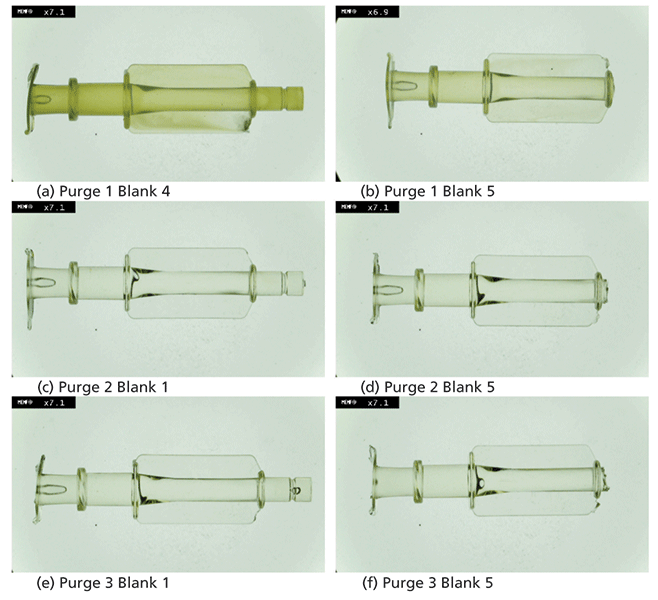
Figure 1: Visual inspection of the sample hubs; (a) through (f) show different conditions (as indicated for each inset figure).
Optical imaging of the hubs was carried out using an Ash Inspex inspection camera and a Leica M165 inspection microscope. NIR spectra were recorded using a Perkin Elmer Spotlight 400 fitted with a NIRA reflection NIR accessory. Each spectrum was accumulated from 32 scans at 16 cm-1 resolution. ATR-MIR spectra were recorded using a Perkin Elmer UATR accessory. Each spectrum was averaged from 16 scans at a resolution of 1 cm-1.
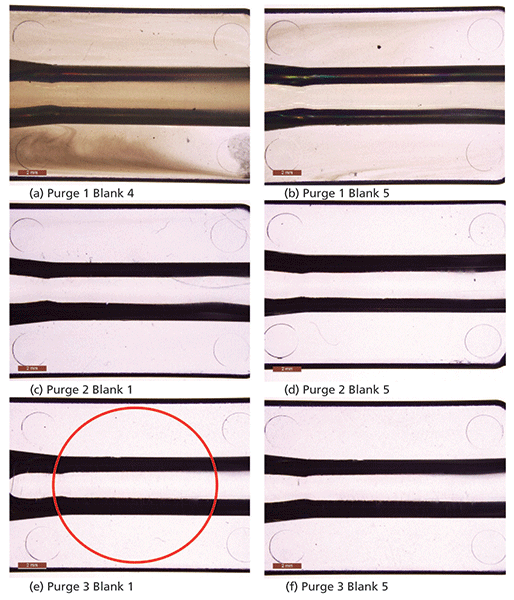
Figure 2: Imaging of the hub area measured using the NIR spectrometer. The sampling area of the NIR measurement is shown on sample (e); (a) through (f) show different conditions (as indicated for each inset figure).
Multivariate analysis of spectral data was carried out using Camo Unscrambler software. Principal component analysis (PCA) was calculated using a singular value decomposition (SVD) algorithm. PCA was calculated using the first derivative of the NIR spectra. The derivative spectra were calculated using a Savitzky-Golay algorithm with a second order polynomial. Derivative spectra were processed using standard normal variate (SNV) normalization. Multivariate curve resolution (MCR) was calculated using an alternating least squares algorithm with a maximum number of 50 iterations. The constraints of non-negativity and closure were applied to the MCR model. The spectra of the reference polystyrene and nylon were used as pure components in an "initial guess" model. MCR was performed on spectra processed using SNV normalization.
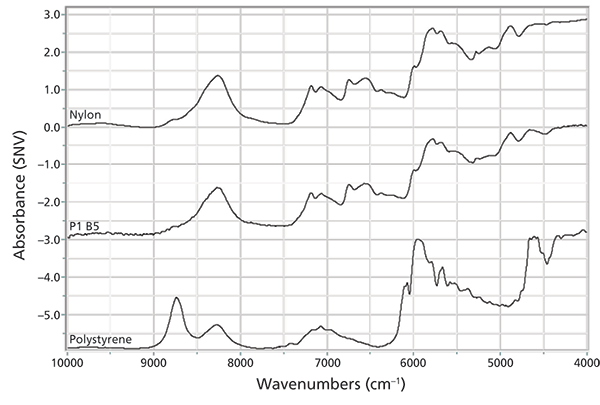
Figure 3: NIR spectra (as absorbance vs. wavenumbers) for reference materials nylon, polystyrene, and P1 B5. The spectra presented here are offset, and have been processed using standard normal variate (SNV) correction.
Results and Discussion
Initial assessment of the hubs was carried out visually. In the case of the blanks prepared after the first purge, purge residue carried over from the process is visible as cloudy material distributed heterogeneously through the hub body. The fourth and fifth blanks are included in Figure 1 as a reference to visible hub contamination after purging. The first and fifth blanks prepared after two subsequent purges showed no visible signs of purge residue carry over. With visual examination alone, it is not certain whether the polystyrene used to purge the injection mold barrel is completely absent from these sets of blanks. For example, the cloudy material observed for the blanks prepared after the first purge may be attributed to the purge polystyrene, residues from the barrel or a combination of both.

Figure 4: ATR-MIR spectra (as absorbance vs. wavenumbers) for reference materials nylon, polystyrene, and P1 B5. The spectra presented here are stacked, and have been processed using standard normal variate (SNV) correction.
NIR measurements were made on the blank hubs, the purge material and the nylon pellets. Figure 2 shows the part of the hub at which the NIR measurements was made. Figure 3 shows examples of the NIR absorption spectra recorded from the hub samples. The reference spectra for the purge and hub materials have distinct peaks associated with their chemical composition that allow them to be distinguished from one another. The NIR spectrum of polystyrene exhibits absorption peaks related to the first and second overtones of the aromatic C-H stretch vibration at 5945 cm-1 and 8743 cm-1, respectively (5). The NIR spectrum of nylon exhibits absorption peaks assigned to the amide N-H group found at 4880 cm-1 and 6752 cm-1. C-H absorption peaks relating to the first and second overtones of the stretching absorption are observed in the nylon spectrum at 5786 cm-1 and 8263 cm-1 , respectively. In the polystyrene spectrum, these peaks are observed at 5792 cm-1 and 8268 cm-1, respectively (6).
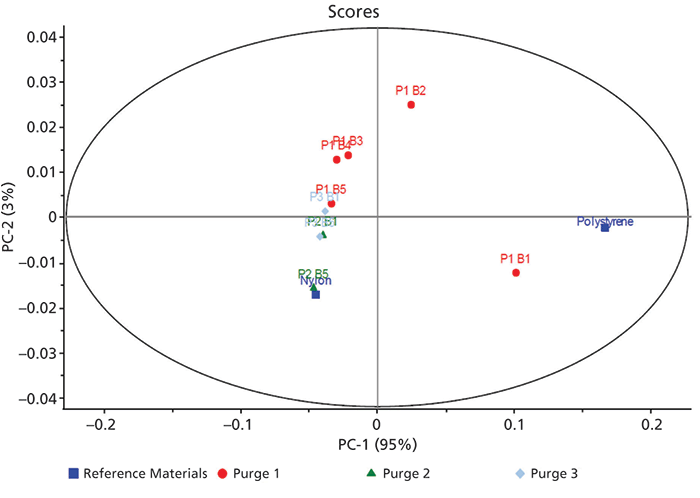
Figure 5: Principal component analysis (PCA) of "blank" hubs after purging and reference materials (nylon and polystyrene).
PCA of the spectral data is shown in Figure 5. The blank hubs from the first five runs after the first purge show the largest scatter in the plot. The first blank after the first purge groups closest with the score calculated for the purge material. Scores of subsequent samples converge toward that of the nylon reference material. Of the blank samples, the fifth hub from the second purge shows the closest score to that of the nylon reference. This is more clearly presented in Figure 6, where the scores for each sample in the first principal component are presented. One can see there that 94% of the variance in x is explained by the first principal component in the PCA model, and it is interpreted as the component that differentiates between the purge residue and the nylon. This result indicates that the fifth blank of the second purge has the least post-purge contamination relative to the others measured. In the case of both the second and third purges, the fifth blank grouped more closely with the nylon reference spectrum than the first, indicating that the fifth blank has less contamination than the first for each purge.
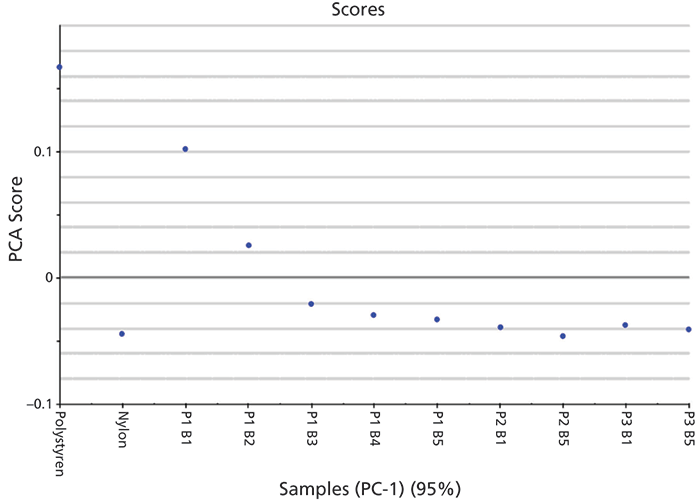
Figure 6: Scores for the hub test samples and materials from the first principal component.
MCR analysis of the spectral data was carried out in order to compare the results with those obtained using the PCA (Figure 7). The trend observed agrees with those found in the results of the PCA. The blanks prepared after the first purge show the largest amount of purge material present relative to samples from subsequent purges. For the second and third purges, the first blank after purging shows a larger degree of purge residue contamination relative to the fifth.
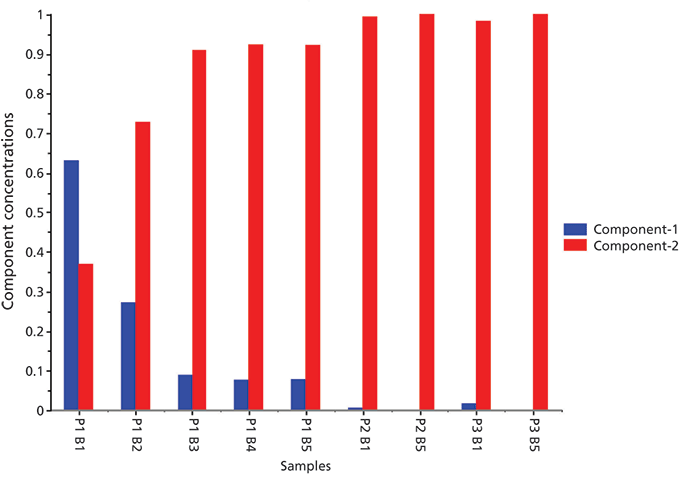
Figure 7: Multivariate curve resolution calculated concentrations of the polystyrene and nylon in the samples hubs. Components 1 and 2 are the polystyrene and nylon, respectively.
It is assumed that the NIR beam penetrates into the bulk of the hub during measurement and, in this manner, reveals bulk properties of the sample. Evidence supporting the validity of this assumption was revealed by performing PCA on ATR spectra of the blank hub samples (Figure 4). Figure 8 shows the scores plot calculated for ATR spectra recorded from the surface of each hub blank. The first principal component (PC 1) describes the difference between the spectral response of the nylon and the polystyrene reference materials. It accounts for 98% of the variance in the data. The first hub of the first purge is the only hub that shows any significant trending toward the polystyrene region of the scores plot. The spectral data of the remaining hubs score similar to the nylon reference for this component. This indicates that the NIR measurements have a better sensitivity to the composition of the bulk of the polymer sample than the ATR measurement.
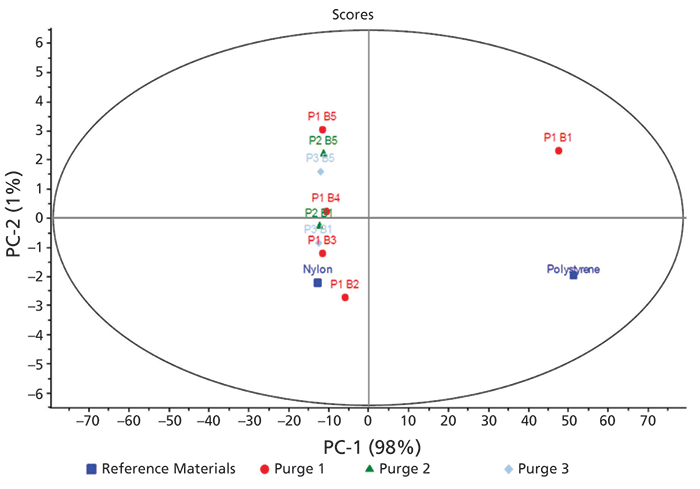
Figure 8: Scores plot calculated for the ATR spectra recorded at the surface of selected hub samples from the first and second principal components.
Conclusions
A combination of NIR and multivariate analysis techniques has allowed for a detailed characterization of changes in material composition during a purging process. The information revealed allows for a reliable identification of the point at which the purging process is complete, and no further purging is necessary. This information is useful in the context of process management for routine implementation and efficiency; in particular, in an industrial context where unnecessary process steps can lead to large waste in the context of annual accumulation. The technique described is non-destructive, and the results are relevant to the bulk composition of the materials of interest.
References
(1) D.V. Rosato and M.V. Rosato, Plastic Product Material and Process Selection Handbook (Elsevier Science & Technology Books, Oxford, United Kingdom, 2004).
(2) K.A.B. Lee and S.C. Johnson, Appl. Spectrosc. Rev. 28(3), 231–284 (1993).
(3) T. Rajalahti and O.M. Kvalheim, Int. J. Pharm. 417(1–2), 280–290 (2011).
(4) T. Azzouz and R. Tauler, Talanta 74(5), 1201–1210 (2008).
(5) J. Workman, Jr. and L. Weyer, Practical Guide and Spectral Atlas for Interpretive Near-Infrared Spectroscopy (CRC Press, Boca Raton, Florida, 2nd ed., 2012).
(6) P. Taylor, and C.E. Miller, Appl. Spectrosc. Rev. 26(4), 277–339 (1991).
Killian Barton, Michael McAuliffe and Liam Lewis are with the Centre for Advance Photonics and Process Analysis (CAPPA), at the Cork Institute of Technology, in Bishopstown, County of Cork, Ireland. Direct correspondence to: Killian.Barton@cit.ie
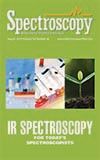
LIBS Illuminates the Hidden Health Risks of Indoor Welding and Soldering
April 23rd 2025A new dual-spectroscopy approach reveals real-time pollution threats in indoor workspaces. Chinese researchers have pioneered the use of laser-induced breakdown spectroscopy (LIBS) and aerosol mass spectrometry to uncover and monitor harmful heavy metal and dust emissions from soldering and welding in real-time. These complementary tools offer a fast, accurate means to evaluate air quality threats in industrial and indoor environments—where people spend most of their time.
NIR Spectroscopy Explored as Sustainable Approach to Detecting Bovine Mastitis
April 23rd 2025A new study published in Applied Food Research demonstrates that near-infrared spectroscopy (NIRS) can effectively detect subclinical bovine mastitis in milk, offering a fast, non-invasive method to guide targeted antibiotic treatment and support sustainable dairy practices.
Smarter Sensors, Cleaner Earth Using AI and IoT for Pollution Monitoring
April 22nd 2025A global research team has detailed how smart sensors, artificial intelligence (AI), machine learning, and Internet of Things (IoT) technologies are transforming the detection and management of environmental pollutants. Their comprehensive review highlights how spectroscopy and sensor networks are now key tools in real-time pollution tracking.